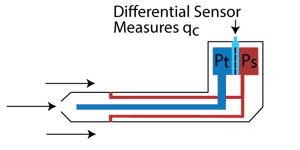Wind tunnels are used around the world for measuring the effects of air movement around objects. Airplanes, automobiles, rockets and even buildings can all be tested in a wind tunnel. Some wind tunnels are large enough to accommodate the actual object being tested, while others utilize precisely scaled-down models. These facilities test vehicles and structures in order to determine efficiency, safety and performance.
There are all sorts of measurements being taken in a wind tunnel, from force, air speed and pressure to humidity and temperature. Pitot tubes are used to measure the wind speed in the wind tunnel and to measure pressure and wind speed on different surfaces of an aircraft or other structures. The wind speed can be calculated using the impact pressure (Qc), created when air hits a pressure sensing element. Qc is calculated by subtracting the ambient pressure, or Static Pressure (Ps), from the Total Pressure (Pt). Mathematically this is expressed as Qc = Pt-Ps. Qc is the resultant force of air that is attributable to the air flow regardless of the existing ambient pressure.
 Pt and Ps are absolute pressures and Qc is a differential pressure. Transducers of each kind may be employed in wind tunnels to measure these pressure components. Different levels of accuracy and pressure resolution are used in each area of the wind tunnel. High accuracy sensors are typically used to read the wind speed in the tunnel where more numerous and possibly lower accuracy sensors are used to measure values coming from various points on the device or structure under test. Typically these sensors are in transducers that send analog or digital signals to a control and data acquisition system. Tests are run and information is collected from all sensors in the wind tunnel to assess the viability of design and to evaluate the performance of the device under test.
Pt and Ps are absolute pressures and Qc is a differential pressure. Transducers of each kind may be employed in wind tunnels to measure these pressure components. Different levels of accuracy and pressure resolution are used in each area of the wind tunnel. High accuracy sensors are typically used to read the wind speed in the tunnel where more numerous and possibly lower accuracy sensors are used to measure values coming from various points on the device or structure under test. Typically these sensors are in transducers that send analog or digital signals to a control and data acquisition system. Tests are run and information is collected from all sensors in the wind tunnel to assess the viability of design and to evaluate the performance of the device under test.
As this technology has advanced, testing facilities have become more sophisticated and are able to determine more than just wind speed and altitude. Safety and efficiency parameters can also be examined using pressure measurement. Measurements in aircraft such as lift, angle of attack and load forces on every surface can be determined. Requirements for more readings, and more accurate readings, will require more pressure monitoring throughout a testing facility. As this happens, more people are turning to high-accuracy pressure sensors and controllers to monitor and verify critical wind tunnel systems. Multi-channel precision pressure controllers have been utilized in wind tunnel systems to check for leaks, verify and calibrate transducers and act as a back up to the transducers in the wind tunnel.
Wind Tunnel Application Example
An aerospace customer expressed a need for additional high accuracy pressure readings in a wind tunnel application. They needed a precise set of measurements taken from multiple sensors simultaneously within a 100-microsecond measurement window. For this, a custom pressure controller was designed in order to meet their requirements. A pressure controller was able to provide them with differential pressure readings using multiple transducers and a barometric reference transducer at the speed they needed. The pressure controller was also utilized to troubleshoot system leaks.
Other considerations in choosing instruments for a wind tunnel are the instruments communication method (GPIB, Ethernet, USB, IEEE), the ease of service (durability, modularity), and the calibration interval. While many controllers can only promise a 180-day calibration interval for their transducers, the Mensor custom systems Model 9476 and Model 9427 that were especially designed for wind tunnel applications, have a one-year calibration interval. The calibration interval and removable transducers make this type of instrument ideal for test environments where downtime can stall production or make the facility unavailable.
While pressure data is valuable information to have in a wind tunnel, verification of the integrity and calibration of the entire system is critical. A multi-channel pressure controller is often the perfect fit for calibration and system testing and verification.
Related Reading:






